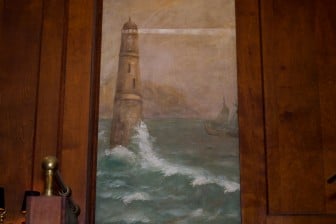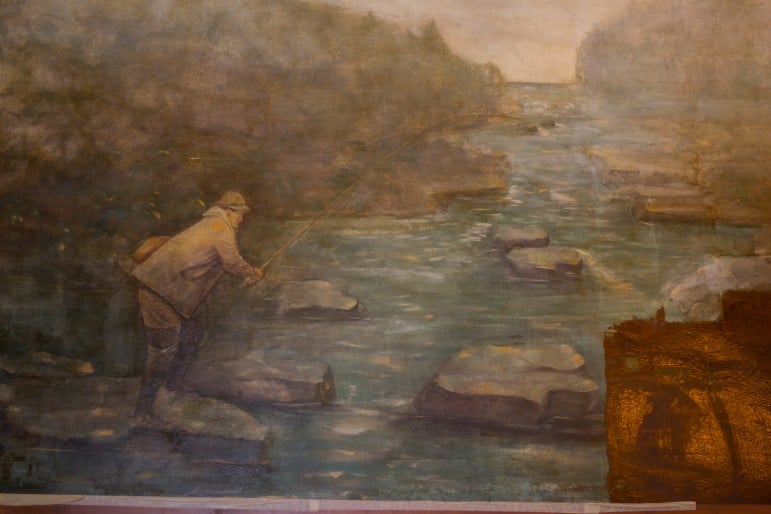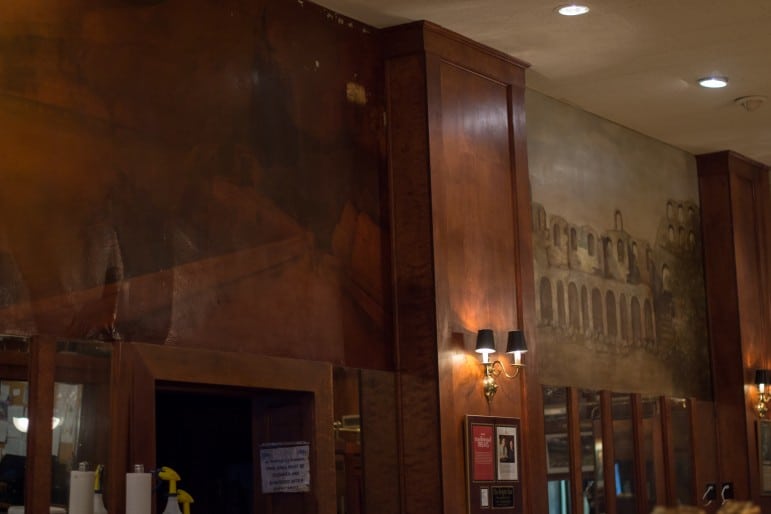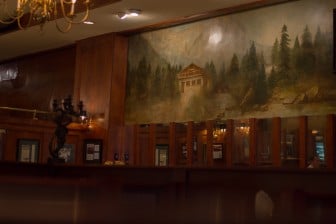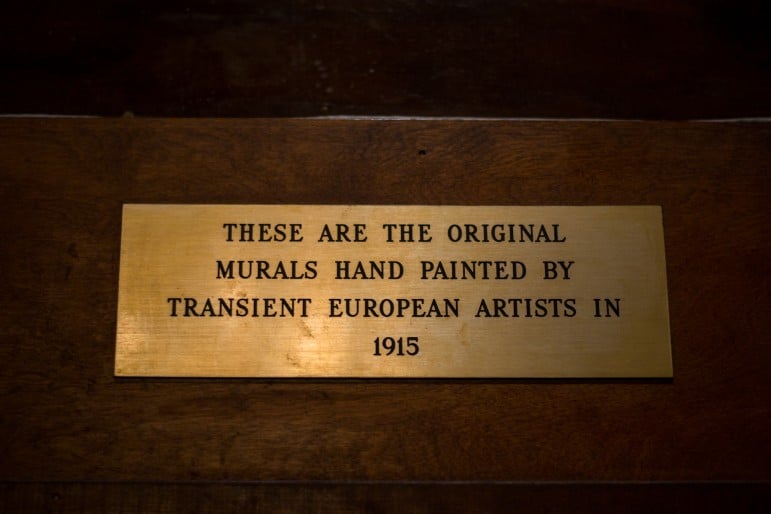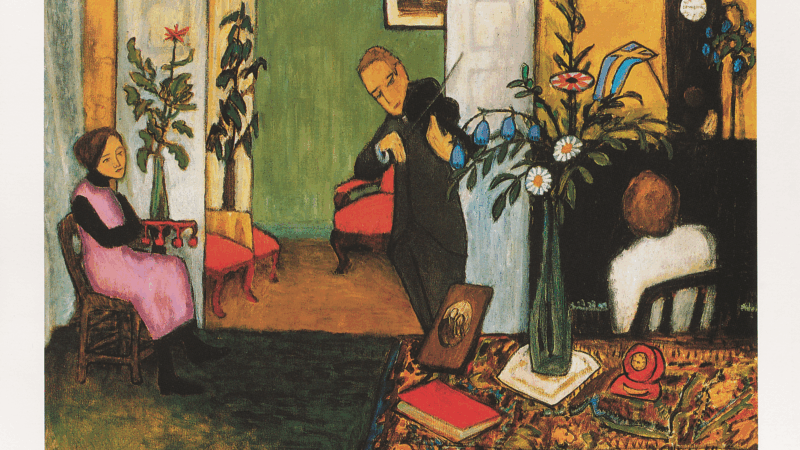100 Year-Old Mural in Bessemer Gets a Makeover
When the ceiling of the Sistine Chapel was restored in the 1980s and 90s, people were awe struck by the transformation. Vibrant colors and details that had been hidden for centuries could be seen once again. At the Bright Star in Bessemer, which bills itself as the oldest continuously operating restaurant in Alabama, the staff is experiencing similar feelings as the eatery’s more than 100 year-old mural slowly gets a makeover.
Bright Star manager, Andreas Anastassakis, has witnessed fisherman, Appalachian rivers and giant evergreen trees appear on the walls around him. The most surprising discovery? “The lighthouse, the small one above the women’s restroom,” Anastassakis says, “I mean you saw the light shining off of the lighthouse. I mean, we really had no idea what was there.”
The paintings are covered with a layer of film as dark as the wood paneling that lines the dining room walls. The coating in some places was so thick that the staff couldn’t tell what was underneath, Anastasskis says.
The lighthouse is just one of the impressionist-style paintings that make up the Bright Star mural. The owners say it was hand painted in the early 20th century by several unknown European artists who traveled through Bessemer by railroad.
The man commissioned for the restoration is art conservationist John Bertalan. “I stick together things which should stick and don’t and unstick things which have stuck together but shouldn’t,” says Bertalan, describing his work.
Matt Diffie,WBHM
This is an up close view of one of the paintings. Notice the bottom right corner is still covered with grime. Bertalan said previous staff used an oil-based cleaning product to try to keep this painting clean, but it only added more oil to the painting which was already covered with layers of grease and smoke.
Bertalan’s been working on this project for more than a year and he’s only about halfway done. And it’s not that he’s slow. Imagine how much gunk can build up on a restaurant wall over a hundred-year period, especially during a time when people still smoked indoors.
“So what happened was you had cooking grease and smoke, and a layer of varnish,” he says. “Then you had a layer of cooking grease and smoke and a layer of varnish.”
Then, in 2003, Alabama essentially banned smoking in public buildings and the Bright Star followed suit. “Then you had cooking grease and no smoke and the final layer of varnish,” Bertalan continues.
Multiple layers of grime plus the age of the mural equals a methodical and delicate cleaning process. Bertalan applies a chemical mixture to a fine cloth and lays that over a small section of the mural. Once the film has absorbed the solution, it begins to separate from the painting. Bertalan then uses a Q-tip to gently remove the film one layer at a time. He says it takes three hours to clean just a square foot of wall space down to the paint layer.
Three hours is basically all the time Bertalan has in a day to work on this project. The Bright Star is still open for business. Bertalan is there most mornings from 7-10 a.m., before customers arrive. Staff and patrons have been able to watch the slow transformation over the last 15 months.
“We thought they were beautiful as they were,” says Matthew Dugger, a server at the restaurant. “We thought they were historical looking and just kind of a constant reminder of how long the restaurant’s been here.”
“We’ve had all different comments from our guests,” Anastasskis adds. “At the beginning, some guests even made the comment, ‘I wish you wouldn’t do that.’ Because they’ve been here for so long and they think you’re changing things. We’ve had other people come in and they think that we’re repainting them.”
Anastassakis says he and Bertalan are considering not cleaning one of the paintings, so when patrons have questions, Bright Star staff have a before and after visual.
No one knows exactly how much longer the restoration is going to take, but Bertalan is confident he’ll finish by October of this year. And, he says, if they need him to come back in another hundred years to clean the murals again, he will. If he’s available.
Viral global TikToks: A twist on soccer, Tanzania’s Charlie Chaplin, hope in Gaza
TikToks are everywhere (well, except countries like Australia and India, where they've been banned.) We talk to the creators of some of the year's most popular reels from the Global South.
This painting is missing. Do you have it?
An important work from a rediscovered artist has been absent from public view since the 1970s. A New York curator is hunting for it.
Memory loss: As AI gobbles up chips, prices for devices may rise
Demand for memory chips currently exceeds supply and there's very little chance of that changing any time soon. More chips for AI means less available for other products such as computers and phones and that could drive up those prices too.
Brigitte Bardot, sex goddess of cinema, has died
Legendary screen siren and animal rights activist Brigitte Bardot has died at age 91. The alluring former model starred in numerous movies, often playing the highly sexualized love interest.
For Ukrainians, a nuclear missile museum is a bitter reminder of what the country gave up
The Museum of Strategic Missile Forces tells the story of how Ukraine dismantled its nuclear weapons arsenal after independence in 1991. Today many Ukrainians believe that decision to give up nukes was a mistake.
Jeffrey R. Holland, next in line to lead Church of Jesus Christ of Latter-day Saints, dies at 85
Jeffrey R. Holland led the Quorum of the Twelve Apostles, a key governing body. He was next in line to become the church's president.

